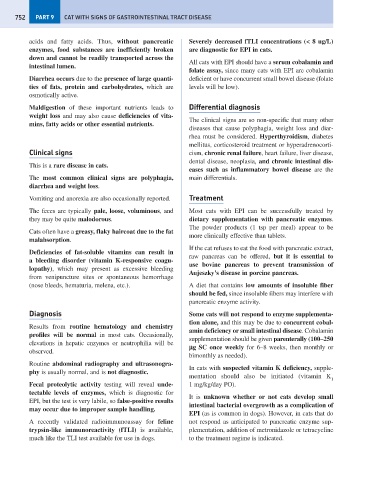Page 760 - Problem-Based Feline Medicine
P. 760
752 PART 9 CAT WITH SIGNS OF GASTROINTESTINAL TRACT DISEASE
acids and fatty acids. Thus, without pancreatic Severely decreased fTLI concentrations (< 8 ug/L)
enzymes, food substances are inefficiently broken are diagnostic for EPI in cats.
down and cannot be readily transported across the
All cats with EPI should have a serum cobalamin and
intestinal lumen.
folate assay, since many cats with EPI are cobalamin
Diarrhea occurs due to the presence of large quanti- deficient or have concurrent small bowel disease (folate
ties of fats, protein and carbohydrates, which are levels will be low).
osmotically active.
Maldigestion of these important nutrients leads to Differential diagnosis
weight loss and may also cause deficiencies of vita-
The clinical signs are so non-specific that many other
mins, fatty acids or other essential nutrients.
diseases that cause polyphagia, weight loss and diar-
rhea must be considered. Hyperthyroidism, diabetes
mellitus, corticosteroid treatment or hyperadrenocorti-
Clinical signs cism, chronic renal failure, heart failure, liver disease,
dental disease, neoplasia, and chronic intestinal dis-
This is a rare disease in cats.
eases such as inflammatory bowel disease are the
The most common clinical signs are polyphagia, main differentials.
diarrhea and weight loss.
Vomiting and anorexia are also occasionally reported. Treatment
The feces are typically pale, loose, voluminous, and Most cats with EPI can be successfully treated by
they may be quite malodorous. dietary supplementation with pancreatic enzymes.
The powder products (1 tsp per meal) appear to be
Cats often have a greasy, flaky haircoat due to the fat
more clinically effective than tablets.
malabsorption.
If the cat refuses to eat the food with pancreatic extract,
Deficiencies of fat-soluble vitamins can result in
raw pancreas can be offered, but it is essential to
a bleeding disorder (vitamin K-responsive coagu-
use bovine pancreas to prevent transmission of
lopathy), which may present as excessive bleeding
Aujeszky’s disease in porcine pancreas.
from venipuncture sites or spontaneous hemorrhage
(nose bleeds, hematuria, melena, etc.). A diet that contains low amounts of insoluble fiber
should be fed, since insoluble fibers may interfere with
pancreatic enzyme activity.
Diagnosis Some cats will not respond to enzyme supplementa-
tion alone, and this may be due to concurrent cobal-
Results from routine hematology and chemistry
amin deficiency or small intestinal disease. Cobalamin
profiles will be normal in most cats. Occasionally,
supplementation should be given parenterally (100–250
elevations in hepatic enzymes or neutrophilia will be
μg SC once weekly for 6–8 weeks, then monthly or
observed.
bimonthly as needed).
Routine abdominal radiography and ultrasonogra-
In cats with suspected vitamin K deficiency, supple-
phy is usually normal, and is not diagnostic.
mentation should also be initiated (vitamin K
1
Fecal proteolytic activity testing will reveal unde- 1 mg/kg/day PO).
tectable levels of enzymes, which is diagnostic for
It is unknown whether or not cats develop small
EPI, but the test is very labile, so false-positive results
intestinal bacterial overgrowth as a complication of
may occur due to improper sample handling.
EPI (as is common in dogs). However, in cats that do
A recently validated radioimmunoassay for feline not respond as anticipated to pancreatic enzyme sup-
trypsin-like immunoreactivity (fTLI) is available, plementation, addition of metronidazole or tetracycline
much like the TLI test available for use in dogs. to the treatment regime is indicated.

